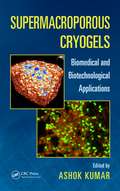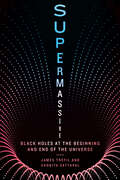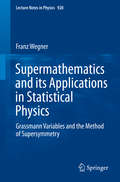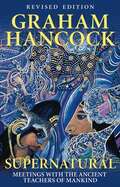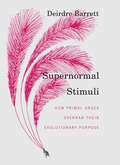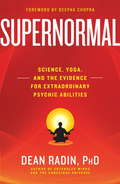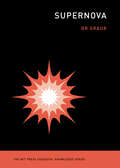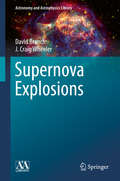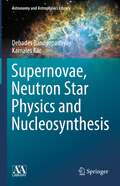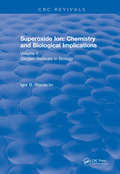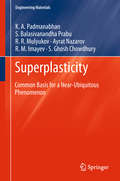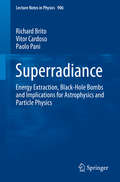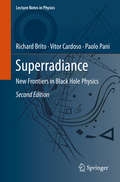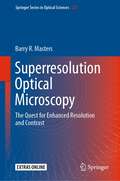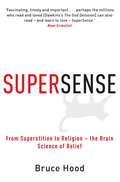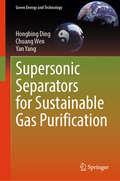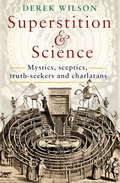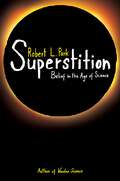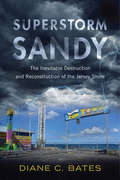- Table View
- List View
Supermacroporous Cryogels: Biomedical and Biotechnological Applications
by Ashok KumarThe process of cryogelation has been vigorously studied over the past two decades, with recent research focussing on applications of these polymer systems in various biomedical and biotechnological fields. While there is significant literature available as research publications, limited reviews, and book chapters, Supermacroporous Cryogels: Biomedi
Supermassive: Black Holes at the Beginning and End of the Universe
by James Trefil Shobita SatyapalBlack holes, demystified: follow along the quest to understand the history and influence of one of space science's most fascinating and confounding phenomenaLed by physicist James Trefil and astrophysicist Shobita Satyapal, this book traverses the incredible history of black holes and introduces contemporary developments and theories on still unanswered questions about the enigmatic objects. From the early work of Albert Einstein and Karl Schwarzschild to an insider look at black hole-galaxy connection research led by co-author Satyapa, the comprehensive book surveys an exciting and evolving branch of space science, with topics that include:Visibility of black holesQuasars, the brightest objects in the universeThe black hole at the center of the Milky WayPopular theories on the origin of black holesCosmic X raysDeath of supermassivesBlack hole collisionsBlack holes in science fictionInvisible to the naked eye and telescopes, black holes have mystified and entranced astronomers, scientists, and humanity for more than a century. The first image of a supermassive black hole was only unveiled in 2019, and new black holes are continually discovered. Supermassive illuminates what we know about black holes so far and what we have yet to uncover.
Supermathematics and its Applications in Statistical Physics
by Franz WegnerThis text presents the mathematical concepts of Grassmannvariables and the method of supersymmetry to a broad audience of physicistsinterested in applying these tools to disordered and critical systems, as wellas related topics in statistical physics. Based on many courses and seminarsheld by the author, one of the pioneers in this field, the reader is given asystematic and tutorial introduction to the subject matter. The algebra and analysis of Grassmann variables ispresented in part I. The mathematics of these variables is applied to a randommatrix model, path integrals for fermions, dimer models and the Ising model intwo dimensions. Supermathematics - the use of commuting and anticommutingvariables on an equal footing - is the subject of part II. The properties ofsupervectors and supermatrices, which contain both commuting and Grassmanncomponents, are treated in great detail, including the derivation of integraltheorems. In part III, supersymmetric physical models are considered. Whilesupersymmetry was first introduced in elementary particle physics as exactsymmetry between bosons and fermions, the formal introduction of anticommutingspacetime components, can be extended to problems of statistical physics, and,since it connects states with equal energies, has also found its way intoquantum mechanics. Several models are considered in the applications, afterwhich the representation of the random matrix model by the nonlinearsigma-model, the determination of the density of states and the levelcorrelation are derived. Eventually, the mobility edge behavior is discussedand a short account of the ten symmetry classes of disorder, two-dimensionaldisordered models, and superbosonization is given.
Supernatural: Meetings with the Ancient Teachers of Mankind
by Graham HancockLess than fifty thousand years ago mankind had no art, no religion, no sophisticated symbolism, no innovative thinking. Then, in a dramatic and electrifying change, described by scientists as "the greatest riddle in human history," all the skills and qualities that we value most highly in ourselves appeared already fully formed, as though bestowed on us by hidden powers. In this book, the author sets out to investigate this mysterious "beforeandafter moment" and to discover the truth about the influences that gave birth to the modern human mind. His quest takes him on a detective journey from the stunningly beautiful painted caves of prehistoric France, Spain, and Italy to rock shelters in the mountains of South Africa, where he finds extraordinary Stone Age art. He uncovers clues that lead him to the depths of the Amazon rainforest to drink the powerful hallucinogen Ayahuasca with shamans, whose paintings contain images of "supernatural beings" identical to the animalhuman hybrids depicted in prehistoric caves. Hallucinogens such as mescaline also produce visionary encounters with exactly the same beings. Scientists at the cutting edge of consciousness research have begun to consider the possibility that such hallucinations may be real perceptions of other "dimensions." Could the "supernaturals" first depicted in the painted caves be the ancient teachers of mankind? Could it be that human evolution is not just the "meaningless" process that Darwin identified, but something more purposive and intelligent that we have barely begun to understand?
Supernavigators: Exploring The Wonders Of How Animals Find Their Way
by David Barrie“Just astonishing . . . Our natural navigational capacities are no match for those of the supernavigators in this eye-opening book.”—Frans de Waal, The New York Times Book Review Publisher’s note: Supernavigators was published in the UK under the title Incredible Journeys. Animals plainly know where they’re going, but how they know has remained a stubborn mystery—until now. Supernavigators is a globe-trotting voyage of discovery alongside astounding animals of every stripe: dung beetles that steer by the Milky Way, box jellyfish that can see above the water (with a few of their twenty-four eyes), sea turtles that sense Earth’s magnetic field, and many more. David Barrie consults animal behaviorists and Nobel Prize–winning scientists to catch us up on the cutting edge of animal intelligence—revealing these wonders in a whole new light.
Supernormal Stimuli: How Primal Urges Overran Their Evolutionary Purpose
by Deirdre BarrettA Harvard psychologist explains how our once-helpful instincts get hijacked in our garish modern world. Our instincts--for food, sex, or territorial protection-- evolved for life on the savannahs 10,000 years ago, not in today's world of densely populated cities, technological innovations, and pollution. We now have access to a glut of larger-than-life objects, from candy to pornography to atomic weapons--that gratify these gut instincts with often-dangerous results. Animal biologists coined the term "supernormal stimuli" to describe imitations that appeal to primitive instincts and exert a stronger pull than real things, such as soccer balls that geese prefer over eggs. Evolutionary psychologist Deirdre Barrett applies this concept to the alarming disconnect between human instinct and our created environment, demonstrating how supernormal stimuli are a major cause of today's most pressing problems, including obesity and war. However, Barrett does more than show how unfettered instincts fuel dangerous excesses. She also reminds us that by exercising self-control we can rein them in, potentially saving ourselves and civilization.
Supernormal: Science, Yoga, And The Evidence For Extraordinary Psychic Abilities
by Dean RadinCan yoga and meditation unleash our inherent supernormal mental powers, such as telepathy, clairvoyance, and precognition? Is it really possible to perceive another person's thoughts and intentions? Influence objects with our minds? Envision future events? And is it possible that some of the superpowers described in ancient legends, science fiction, and comic books are actually real, and patiently waiting for us behind the scenes? Are we now poised for an evolutionary trigger to pull the switch and release our full potentials?Dean Radin, Director of Research at the Institute of Noetic Sciences (IONS) and bestselling author of The Conscious Universe, presents persuasive new experimental evidence for the existence of such phenomena. He takes us on a thrilling scientific journey and challenges outdated assumptions that these abilities are mere superstition. Focusing on Patanjali's mysterious Yoga Sutras -- 2,000 year-old meditation practices believed to release our extraordinary powers -- Radin offers powerful evidence confirming that sometimes fact is much stranger, spookier, and more wonderful than the wildest fiction.
Supernova (The MIT Press Essential Knowledge series)
by Or GraurA concise illustrated introduction to the history and physics of supernovae, the brilliant explosions of stars; with striking color illustrations. Supernovae are the explosions of stars. They are some of the most energetic phenomena in the Universe, rivaling the combined light of billions of stars. Supernovae have been studied for centuries, and they have also made appearances in popular culture: a glimpse of a supernova in a painting provides Sherlock Holmes with a crucial clue, for example. In this volume in the MIT Press Essential Knowledge series, astrophysicist Or Graur offers a concise and accessible introduction to these awe-inspiring astronomical phenomena. Graur explains that a deep observational understanding of supernovae—why and how they shine and how their brightness changes over time—allows us to use them as tools for experiments in astrophysics and physics. A certain type of supernova, for example, brightens and fades in such a predictable manner that we can measure the distances to their host galaxies. We owe our existence to supernovae—they give us iron for our blood and calcium for our bones. But supernovae may also have caused a mass extinction event on Earth 2.6 million years ago. Graur shows how observations of supernovae played a role in the transformation of astronomy from astrology to astrophysics; surveys the tools used to study supernovae today; and describes the lives and deaths of stars and the supernova remnants, neutron stars, and black holes they leave behind. Illustrations in both color and black and white, many from Graur&’s own Hubble Space Telescope data, make this account of supernovae particularly vivid.
Supernova Explosions
by J. Craig Wheeler David BranchTargeting advanced students of astronomy and physics, as well as astronomers and physicists contemplating research on supernovae or related fields, David Branch and J. Craig Wheeler offer a modern account of the nature, causes and consequences of supernovae, as well as of issues that remain to be resolved. Owing especially to (1) the appearance of supernova 1987A in the nearby Large Magellanic Cloud, (2) the spectacularly successful use of supernovae as distance indicators for cosmology, (3) the association of some supernovae with the enigmatic cosmic gamma-ray bursts, and (4) the discovery of a class of superluminous supernovae, the pace of supernova research has been increasing sharply. This monograph serves as a broad survey of modern supernova research and a guide to the current literature. The book's emphasis is on the explosive phases of supernovae. Part 1 is devoted to a survey of the kinds of observations that inform us about supernovae, some basic interpretations of such data, and an overview of the evolution of stars that brings them to an explosive endpoint. Part 2 goes into more detail on core-collapse and superluminous events: which kinds of stars produce them, and how do they do it? Part 3 is concerned with the stellar progenitors and explosion mechanisms of thermonuclear (Type Ia) supernovae. Part 4 is about consequences of supernovae and some applications to astrophysics and cosmology. References are provided in sufficient number to help the reader enter the literature.
Supernovae, Neutron Star Physics and Nucleosynthesis (Astronomy and Astrophysics Library)
by Debades Bandyopadhyay Kamales KarThis book deals with the interdisciplinary areas of nuclear physics, supernovae and neutron star physics. It addresses the physics and astrophysics of the spectacular supernova explosions, starting with the collapse of massive stars and ending with the birth of neutron stars or black holes. Recent progress in the understanding of core collapse supernova (CCSN) and observational aspects of future detections of neutrinos from CCSN explosions are discussed. The other main focus in this text is the novel phases of dense nuclear matter, its compositions and equation of state (EoS) from low to very high baryon density relevant to supernovae and neutron stars. The multi-messenger astrophysics of binary neutron star merger GW170817 and its relation to EoS through tidal deformability are also presented in detail. The synthesis of elements heavier than iron in the supernova and neutron star environment by the rapid (r)-process are treated here with special emphasis on the nucleosynthesis in the ejected material from GW170817. This monograph is written for graduate students and researchers in the field of nuclear astrophysics.
Superoxide Ion Chemistry and Biological Implications
by Igor B. Afanas'evThe chemical properties of superoxide ion, its biological role, and the role of other oxygen radicals which arise as a result of its transformations are contained in this text. In Volume I the principal reactions of superoxide ion, including protonation reactions with proton donors, nucleophilic reactions with esters, alkyl halides and other compounds, electron transfer reactions with quinones and metal complexes, are described. Basic quantitative data including rate constants and yields for the reactions of superoxide ion of all types are given in tables. This volume contains the mechanisms of the generation of oxygen radicals in cells and the interaction of superoxide ion with cell components. The role of superoxide ion in lipid peroxidation and destruction of proteins and nucleic acids is explained, as well as oxygen radicals in the mechanisms of toxic and therapeutic action of drugs, especially anticancer antibiotics. In addition, the action of superoxide ion and other oxygen radicals on plants, micro-, and macroorganisms is discussed, along with the role of oxygen radicals in normal metabolic and pathological processes.
Superoxide Ion: Chemistry and Biological Implications (CRC Press Revivals)
by Igor B. Afanas'evThe chemical properties of superoxide ion, its biological role, and the role of other oxygen radicals which arise as a result of its transformations are contained in this text. In Volume I the principal reactions of superoxide ion, including protonation reactions with proton donors, nucleophilic reactions with esters, alkyl halides and other compounds, electron transfer reactions with quinones and metal complexes, are described.
Superplasticity: Common Basis for a Near-Ubiquitous Phenomenon (Engineering Materials)
by K. A. Padmanabhan S. Balasivanandha Prabu R. R. Mulyukov Ayrat Nazarov R. M. Imayev S. Ghosh ChowdhuryThis book combines the perspectives of materials science of Superplasticity, on the one hand, and those of design and mechanics, on the other, in order to provide a holistic view of materials, design, mechanics and performance which will lead to useful solutions of societal benefits, in addition to providing great intellectual challenges. After considering the experimental evidence for superplasticity in different classes of materials, the book discusses the physics-based models, along with their advantages and limitations. Then, the analyses for superplastic forming available in the framework of continuum mechanics, finite element analysis and numerical simulations are presented. Finally, the authors highlight some successful industrial applications. This book is recommended as a text book for courses on Superplasticity and as supplementary use for courses on Materials Processing, Manufacturing, High Temperature Deformation, Nanotechnology and Mechanical Behavior of Materials. Persons working in Department of Materials Science and Engineering, Physics, Mechanics, Mechanical Engineering, Aerospace Engineering, Metallurgy, Ceramics and Geo-sciences are likely to find the book to be useful. It is also recommended as a reference source for practicing engineers involved in the design, processing and manufacture of industrial components, which exploit the unique properties associated with superplastic materials.
Superquake!: Why Earthquakes Occur and When the Big One Will Hit Southern California
by David RitchieIt's coming, sometime within your lifetime, as inexorably as approaching thunder--the biggest earthquake to hit the West Coast since San Francisco was demolished in 1906. This time the target most likely will be southern California and the sprawling, populous city of Los Angeles. And this time the devastation will be greater than ever before, because in the eighty-odd years since the last great quake we have become so much more dependent on our technology. It won't be just toppled buildings and broken roads this time, but the complete disruption of transportation and communication systems, the breakdown of medical services, the destruction of water resources, widespread spilling of toxic chemicals and volatile fuels, and the leakage of radioactive materials. Angelenos can forget about the bomb; they are building their future in the shadow of an equally destructive and much more inevitable catastrophe. Science writer David Ritchie takes a hard look at the evidence predicting a devastating earthquake for southern California sometime within the next fifty years. What causes earthquakes, and how can earth scientists be so certain that a major earthquake is coming? Ritchie surveys the history of California quakes and shows that, while individual generations of Californians may escape catastrophe, on a geologic time scale the West Coast is highly unstable and ripe for disaster.
Superradiance
by Richard Brito Vitor Cardoso Paolo PaniThis volume gives a unified picture of the multifaceted subject of superradiance, with a focus on recent developments in the field, ranging from fundamental physics to astrophysics. Superradiance is a radiation enhancement process that involves dissipative systems. With a 60 year-old history, superradiance has played a prominent role in optics, quantum mechanics and especially in relativity and astrophysics. In Einstein's General Relativity, black-hole superradiance is permitted by dissipation at the event horizon, which allows energy extraction from the vacuum, even at the classical level. When confined, this amplified radiation can give rise to strong instabilities known as "blackhole bombs'', which have applications in searches for dark matter, in physics beyond the Standard Model and in analog models of gravity. This book discusses and draws together all these fascinating aspects of superradiance.
Superradiance: New Frontiers in Black Hole Physics (Lecture Notes In Physics Series #971)
by Richard Brito Vitor Cardoso Paolo PaniThis book focuses on one mechanism in black hole physics which has proven to be universal, multifaceted and with a rich phenomenology: rotational superradiance. This is an energy extraction process, whereby black holes can deposit their rotational energy in their surroundings, leading to Penrose processes, black-hole bombs, and even Hawking radiation. Black holes are key players in star formation mechanisms and as engines to some of the most violent events in our universe. Their simplicity and compactness make them perfect laboratories, ideally suited to probe new fields or modifications to the theory of gravity. Thus, black holes can also be used to probe some of the most important open problems in physics, including the nature of dark matter or the strong CP problem in particle physics. This monograph is directed to researchers and graduate students and provides a unified view of the subject, covering the theoretical machinery, experimental efforts in the laboratory, and astrophysics searches. It is focused on recent developments and works out a number of novel examples and applications, ranging from fundamental physics to astrophysics. Non-specialists with a scientific background should also find this text a valuable resource for understanding the critical issues of contemporary research in black-hole physics. This second edition stresses the role of ergoregions in superradiance, and completes its catalogue of energy-extraction processes. It presents a unified description of instabilities of spinning black holes in the presence of massive fields. Finally, it covers the first experimental observation of superradiance, and reviews the state-of-the-art in the searches for new light fields in the universe using superradiance as a mechanism.
Superresolution Optical Microscopy: The Quest for Enhanced Resolution and Contrast (Springer Series in Optical Sciences #227)
by Barry R. MastersThis book presents a comprehensive and coherent summary of techniques for enhancing the resolution and image contrast provided by far-field optical microscopes. It takes a critical look at the body of knowledge that comprises optical microscopy, compares and contrasts the various instruments, provides a clear discussion of the physical principles that underpin these techniques, and describes advances in science and medicine for which superresolution microscopes are required and are making major contributions. The text fills significant gaps that exist in other works on superresolution imaging, firstly by placing a new emphasis on the specimen, a critical component of the microscope setup, giving equal importance to the enhancement of both resolution and contrast. Secondly, it covers several topics not typically discussed in depth, such as Bessel and Airy beams, the physics of the spiral phase plate, vortex beams and singular optics, photoactivated localization microscopy (PALM), stochastic optical reconstruction microscopy (STORM), structured illumination microscopy (SIM), and light-sheet fluorescence microscopy (LSFM). Several variants of these techniques are critically discussed. Noise, optical aberrations, specimen damage, and artifacts in microscopy are also covered. The importance of validation of superresolution images with electron microscopy is stressed. Additionally, the book includes translations and discussion of seminal papers by Abbe and Helmholtz that proved to be pedagogically relevant as well as historically significant. This book is written for students, researchers, and engineers in the life sciences, medicine, biological engineering, and materials science who plan to work with or already are working with superresolution light microscopes. The volume can serve as a reference for these areas while a selected set of individual chapters can be used as a textbook for a one-semester undergraduate or first-year graduate course on superresolution microscopy. Moreover, the text provides a captivating account of curiosity, skepticism, risk-taking, innovation, and creativity in science and technology. Good scientific practice is emphasized throughout, and the author’s lecture slides on responsible conduct of research are included as an online resource which will be of interest to students, course instructors, and scientists alike.
Supersense: From Superstition to Religion - The Brain Science of Belief
by Bruce HoodWhy is it that Tony Blair always wore the same pair of shoes when answering Prime Minister's Questions? That John McEnroe notoriously refused to step on the white lines of a tennis court between points? And that President-elect Barack Obama played a game of basketball the morning of his victory in the Iowa primary, and continued the tradition the day of every following primary? Superstitious habits are common. Do you ever cross your fingers, knock on wood, avoid walking under ladders, or step around black cats? Sentimental value often supersedes material worth. If someone offered to replace your childhood teddy bear or wedding ring with a brand new, exact replica, would you do it? How about £20 for trying on a jumper owned by Fred West? Where do such feelings come from and why do most of us have them? Humans are born with brains designed to make sense of the world and that need for an explanation can lead to beliefs that go beyond reason. To be true they would have to be supernatural. With scientific education we learn that such beliefs are irrational but at an intuitive level they can be resistant to reason or lie dormant in otherwise sensible adults.It now seems unlikely that any effort to get rid of supernatural beliefs or superstitious behaviours will be completely successful. This is not all bad news - such beliefs are a useful glue that binds us together as a society. Combining brilliant insight with witty example Hood weaves a page-turning account of our 'supersense' that navigates a path through brain science, child development, popular culture, mental illness and the paranormal. After reading SuperSense, you will realize why you are not as reasonable as you might like to think - and why that might be no bad thing.
Supersonic Separators for Sustainable Gas Purification (Green Energy and Technology)
by Yan Yang Chuang Wen Hongbing DingThis book thoroughly analyzes the crucial role of supersonic separator technology in addressing the challenges of environmental degradation and climate change, particularly highlighting its importance in the dehydration and decarbonization of natural gas. Employing computational fluid dynamics (CFD) modeling and experimental research, along with meticulous data processing and image presentation, the authors extensively investigate the complex phenomena of flow field characteristics and heat and mass transfer mechanisms within supersonic separators. This approach demonstrates the innovative potential of this technology in the field of gas purification. The book also introduces new strategies to enhance separation efficiency through heterogeneous condensation enhancement and multi-objective optimization techniques, providing readers with a deep understanding of the latest research in gas purification. Furthermore, it stimulates in-depth discussions about building efficient energy systems and addressing climate challenges. This book not only presents the latest advancements in supersonic separation technology but also guides readers to consider how to establish an efficient, environmentally friendly, and stable energy system to effectively tackle the challenges of global climate change.
Superstition and Science: Mystics, sceptics, truth-seekers and charlatans
by Derek Wilson'A dazzling chronicle, a bracing challenge to modernity's smug assumptions' - Bryce Christensen, Booklist'O what a world of profit and delightOf power, of honour and omnipotenceIs promised to the studious artisan.'Christopher Marlowe, Dr FaustusBetween the Renaissance and the Enlightenment, Europe changed out of all recognition. Particularly transformative was the ardent quest for knowledge and the astounding discoveries and inventions which resulted from it. The movement of blood round the body; the movement of the earth round the sun; the velocity of falling objects (and, indeed, why objects fall) - these and numerous other mysteries had been solved by scholars in earnest pursuit of scientia. This fascinating account of the profound changes undergone by Europe between the Renaissance and the Enlightenment will cover ground including folk religion and its pagan past; Catholicism and its saintly dogma; alchemy, astrology and natural philosophy; Islamic and Jewish traditions; and the discovery of new countries and cultures.By the mid-seventeenth century 'science mania' had set in; the quest for knowledge had become a pursuit of cultured gentlemen. In 1663 The Royal Society of London for Improving Natural Knowledge received its charter. Three years later the French Academy of Sciences was founded. Most other European capitals were not slow to follow suit. In 1725 we encounter the first use of the word 'science' meaning 'a branch of study concerned either with a connected body of demonstrated truths or with observed facts systematically classified'. Yet, it was only nine years since the last witch had been executed in Britain - a reminder that, although the relationship of people to their environment was changing profoundly, deep-rooted fears and attitudes remained strong.
Superstition and Science: Mystics, sceptics, truth-seekers and charlatans
by Mr Derek Wilson'A dazzling chronicle, a bracing challenge to modernity's smug assumptions' - Bryce Christensen, Booklist'O what a world of profit and delightOf power, of honour and omnipotenceIs promised to the studious artisan.'Christopher Marlowe, Dr FaustusBetween the Renaissance and the Enlightenment, Europe changed out of all recognition. Particularly transformative was the ardent quest for knowledge and the astounding discoveries and inventions which resulted from it. The movement of blood round the body; the movement of the earth round the sun; the velocity of falling objects (and, indeed, why objects fall) - these and numerous other mysteries had been solved by scholars in earnest pursuit of scientia. This fascinating account of the profound changes undergone by Europe between the Renaissance and the Enlightenment will cover ground including folk religion and its pagan past; Catholicism and its saintly dogma; alchemy, astrology and natural philosophy; Islamic and Jewish traditions; and the discovery of new countries and cultures.By the mid-seventeenth century 'science mania' had set in; the quest for knowledge had become a pursuit of cultured gentlemen. In 1663 The Royal Society of London for Improving Natural Knowledge received its charter. Three years later the French Academy of Sciences was founded. Most other European capitals were not slow to follow suit. In 1725 we encounter the first use of the word 'science' meaning 'a branch of study concerned either with a connected body of demonstrated truths or with observed facts systematically classified'. Yet, it was only nine years since the last witch had been executed in Britain - a reminder that, although the relationship of people to their environment was changing profoundly, deep-rooted fears and attitudes remained strong.
Superstition: Belief in the Age of Science
by Robert L. ParkWhy the battle between superstition and science is far from overFrom uttering a prayer before boarding a plane, to exploring past lives through hypnosis, has superstition become pervasive in contemporary culture? Robert Park, the best-selling author of Voodoo Science, argues that it has. In Superstition, Park asks why people persist in superstitious convictions long after science has shown them to be ill-founded. He takes on supernatural beliefs from religion and the afterlife to New Age spiritualism and faith-based medical claims. He examines recent controversies and concludes that science is the only way we have of understanding the world.Park sides with the forces of reason in a world of continuing and, he fears, increasing superstition. Chapter by chapter, he explains how people too easily mistake pseudoscience for science. He discusses parapsychology, homeopathy, and acupuncture; he questions the existence of souls, the foundations of intelligent design, and the power of prayer; he asks for evidence of reincarnation and astral projections; and he challenges the idea of heaven. Throughout, he demonstrates how people's blind faith, and their confidence in suspect phenomena and remedies, are manipulated for political ends. Park shows that science prevails when people stop fooling themselves.Compelling and precise, Superstition takes no hostages in its quest to provoke. In shedding light on some very sensitive--and Park would say scientifically dubious--issues, the book is sure to spark discussion and controversy.
Superstorm Sandy
by Diane C. BatesSandy was the costliest hurricane in U.S. history after Katrina, but the waters had barely receded from the Jersey coast when massive efforts began to "Restore the Shore." Why do people build in areas open to repeated natural disasters? And why do they return to these areas in the wake of major devastation? Drawing on a variety of insights from environmental sociology, Superstorm Sandy answers these questions as it looks at both the unique character of the Jersey Shore and the more universal ways that humans relate to their environment. Diane C. Bates offers a wide-ranging look at the Jersey Shore both before and after Sandy, examining the many factors--such as cultural attachment, tourism revenues, and governmental regulation--that combined to create a highly vulnerable coastal region. She explains why the Shore is so important to New Jerseyans, acting as a key cultural touchstone in a state that lacks a central city or even a sports team to build a shared identity among the state's residents. She analyzes post-Sandy narratives about the Jersey Shore that trumpeted the dominance of human ingenuity over nature (such as the state's "Stronger than the Storm" advertising campaign) or proclaimed a therapeutic community ("Jersey Strong")--narratives rooted in emotion and iconography, waylaying any thought of the near-certainty of future storms. The book also examines local business owners, politicians, real estate developers, and residents who have vested interests in the region, explaining why the Shore was developed intensively prior to Sandy, and why restoration became an imperative in the post-storm period. Engagingly written and insightful, Superstorm Sandy highlights the elements that compounded the disaster on the Shore, providing a framework for understanding such catastrophes and preventing them in the future.
Superstring Theory Volume 1: Introduction 25th Anniversary Edition
by John H. Schwarz Michael B. Green Edward WittenTwenty-five years ago, Michael Green, John Schwarz, and Edward Witten wrote two volumes on string theory. Published during a period of rapid progress in this subject, these volumes were highly influential for a generation of students and researchers. Despite the immense progress that has been made in the field since then, the systematic exposition of the foundations of superstring theory presented in these volumes is just as relevant today as when first published. A self-contained introduction to superstrings, Volume 1 begins with an elementary treatment of the bosonic string, before describing the incorporation of additional degrees of freedom: fermionic degrees of freedom leading to supersymmetry and internal quantum numbers leading to gauge interactions. A detailed discussion of the evaluation of tree-approximation scattering amplitudes is also given. Featuring a new Preface setting the work in context in light of recent advances, this book is invaluable for graduate students and researchers in general relativity and elementary particle theory.
Superstring Theory: Volume 2
by John H. Schwarz Michael B. Green Edward WittenTwenty-five years ago, Michael Green, John Schwarz, and Edward Witten wrote two volumes on string theory. Published during a period of rapid progress in this subject, these volumes were highly influential for a generation of students and researchers. Despite the immense progress that has been made in the field since then, the systematic exposition of the foundations of superstring theory presented in these volumes is just as relevant today as when first published. Volume 2 is concerned with the evaluation of one-loop amplitudes, the study of anomalies and phenomenology. It examines the low energy effective field theory analysis of anomalies, the emergence of the gauge groups E8 x E8 and SO(32) and the four-dimensional physics that arises by compactification of six extra dimensions. Featuring a new Preface setting the work in context in light of recent advances, this book is invaluable for graduate students and researchers in high energy physics and astrophysics, as well as mathematicians.
